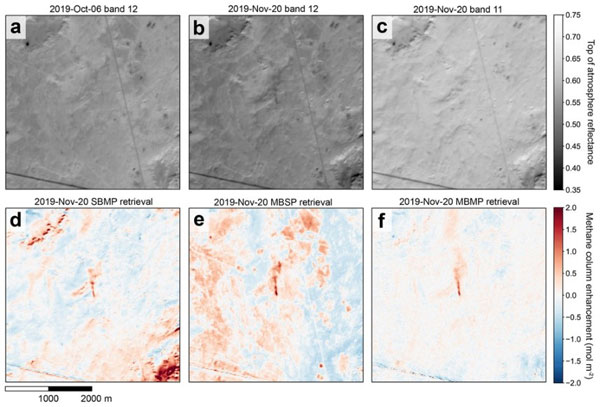At the recent COP26, over 100 countries signed the Global Methane Pledge, an initiative to reduce global methane emissions to keep the goal of limiting warming to 1.5 degrees Celsius within reach—and the Copernicus Sentinel-2 satellites are ready to help.
Methane is a potent greenhouse gas that is responsible for roughly one quarter of the climate warming experienced since preindustrial times.
Surveys of methane-emitting facilities have shown that a small number of anomalously strong point sources contribute a large fraction of total emissions, due to equipment malfunction and/or abnormal operating conditions (Brandt et al., 2016; Frankenberg et al., 2016; Zavala-Araiza et al., 2017; Duren et al., 2019).

This presents an opportunity for effective climate change mitigation, if the strongest point sources can be rapidly identified, repaired, and regularly monitored.
While Copernicus Sentinel-5P is the 'official' mission dedicated to atmospheric monitoring and thus to the detection and monitoring of methane (and other gasses), Copernicus Sentinel-2 keeps demonstrating that it goes beyond its initial aim to monitor land, and is now showing the capability to precisely measure methane leaks from oil/gas facilities.
Satellite observations of atmospheric methane by solar backscatter in the shortwave infrared (SWIR) have unique potential for global and individual monitoring of point sources, but a combination of fine spatial resolution and frequent revisit rate is needed.
A study performed by researchers of the School of Engineering and Applied Science at Harvard University, and GHGSat, Inc., in Canada, demonstrated the capabilities of the Sentinel-2 twin satellites of the European Union’s Copernicus Programme, to detect and quantify strong methane point sources globally, with both fine pixel resolution and frequent revisits.
The researchers demonstrated the capability of the Copernicus Sentinel-2 MultiSpectral Instrument (MSI) to detect and quantify anomalously large methane point sources with fine pixel resolution (20 m) and rapid revisit rates (2–5 days).
They presented three methane column retrieval methods that use SWIR (shortwave infrared) measurements from MSI spectral bands 11 (~1560–1660 nm) and 12 (~2090–2290 nm) to detect atmospheric methane plumes.

They applied their methods to perform high-frequency monitoring of strong methane point source plumes from a well-pad device in the Hassi Messaoud oil field of Algeria (October 2019 to August 2020, observed every 2.5 days) and from a compressor station in the Korpezhe oil and gas field of Turkmenistan (August 2015 to November 2020, observed every 5 days). Their Copernicus Sentinel-2 analysis suggested that the Hassi Messaoud well-pad device contributed about 6% of the total emissions Algeria reported to the United Nations Framework Convention on Climate Change (UNFCCC), for its oil and gas sector. The source was first detected by Copernicus Sentinel-2 on 9 October 2019, and continued until 9 August 2020, by which point the facility operators lit a flare to burn off the emissions.

Copernicus Sentinel-2 has unique capabilities for monitoring atmospheric methane that make it a welcome addition to the larger methane-observing satellite fleet.
Instruments like TROPOMI on Sentinel-5P have global coverage, but spatial resolution too coarse to identify methane plumes from individual facilities. Conversely, instruments like GHGSat have high spatial resolution for detecting individual sources, but only observe targeted patches of Earth.
Copernicus Sentinel-2 combines the strengths of these instruments by observing the whole world every few days with high spatial resolution, thus performing as a complementary mission to methane monitoring.
Dr Daniel Varon, postdoctoral research fellow at Harvard University, states, “The trade-off is that Copernicus Sentinel-2 provides noisier methane data compared to the other satellites, because it was not designed for methane. Its best application is then as a global monitoring system for the world’s largest methane point sources, which are the lowest-hanging fruit for reducing greenhouse gas emissions to slow climate change.
"A next step for the research community is to improve the methane retrieval methods for Copernicus Sentinel-2, so we can detect smaller methane plumes in a broader range of observing conditions. Just as important, we will need to develop big-data and machine-learning solutions to automatically scan the full data record for plumes", concluded Dr Varon.
About the Copernicus Sentinels
The Copernicus Sentinels are a fleet of dedicated EU-owned satellites, designed to deliver the wealth of data and imagery that are central to the European Union's Copernicus environmental programme.
The European Commission leads and coordinates this programme, to improve the management of the environment, safeguarding lives every day. ESA is in charge of the space component, responsible for developing the family of Copernicus Sentinel satellites on behalf of the European Union and ensuring the flow of data for the Copernicus services, while the operations of the Copernicus Sentinels have been entrusted to ESA and EUMETSAT.
Did you know that?
Earth observation data from the Copernicus Sentinel satellites are fed into the Copernicus Services. First launched in 2012 with the Land Monitoring and Emergency Management services, these services provide free and open support, in six different thematic areas.
For instance, the Copernicus Atmosphere Monitoring Service (CAMS) (implemented by the European Centre for Medium-Range Weather Forecasts (ECMWF) on behalf of the European Commission) provides continuous data and information on atmospheric composition. It supports many applications in a variety of domains including health, environmental monitoring, renewable energies, meteorology and climatology.
Acknowledgements
Varon, D. J., Jervis, D., McKeever, J., Spence, I., Gains, D., and Jacob, D. J.: High-frequency monitoring of anomalous methane point sources with multispectral Sentinel-2 satellite observations, Atmos. Meas. Tech., 14, 2771–2785, https://amt.copernicus.org/articles/14/2771/2021/
